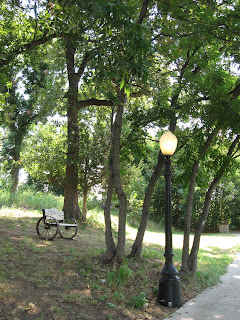 Not so very far from Lawton, Oklahoma, huddles a sleepy little resort town called Medicine Park. It was first created just after the nineteenth century jumped eagerly into the twentieth, and politicians wanted a place to rest from the tension of making laws and running for office.
Not so very far from Lawton, Oklahoma, huddles a sleepy little resort town called Medicine Park. It was first created just after the nineteenth century jumped eagerly into the twentieth, and politicians wanted a place to rest from the tension of making laws and running for office.

A lot of water pours through little streams and wide, shallow rivers onto the tilted plain of Oklahoma. Left to its natural inclinations, this water wouldn't linger, but rush self-centeredly onward to cast itself into the Mississippi and from thence to the sea. Fortunately for Oklahoma, some of the aforementioned politicians decided to dam the rivers and create a jillion little reservoirs to water the villages during our not-so-uncommon droughts. They also built lakes and ponds to supply a few large cities.

One of these reservoirs was just perfect for the building of a little resort. Hence, Medicine Park. For a few years, it thrived. People built tiny cabins from the round stones manufactured in the area, or they camped out by the pond-river and fished. There was a large restaurant and a plethora of social events.

Medicine Park was the place to visit, and everybody who was anybody in Oklahoma spent time there.
Then a few events transpired: The Great Depression, World War I, and World War II to name them.
The town fell into disuse. Walls made of wood and canvas rotted away, but the stone
foundations remained.

Animals moved into the semi-shelters. The restaurant failed, as did the grocery store. For years and years, Medicine Park was a poverty-stricken ghost town. Then, in the optimistic 1990's, some clever developers discovered the place and promptly turned it into "the place to be" again.
There was a mad scramble to buy all the original structures...
 ... build large cabins over and around them, being careful to preserve any round stones, which had become the status trademark of this new, popular hide-away.
... build large cabins over and around them, being careful to preserve any round stones, which had become the status trademark of this new, popular hide-away.Teeny little restaurants opened on the week-ends, and visitors sat out in the Oklahoma shade and talked about how hot it was.
Condos re-opened under modern management, and they were no longer out-dated; they were quaint and rustic.
Some cabins overwhelmed the original buildings, but, as long as they had a round-stone foundation, they were accepted as part of the elite avant-garde society.
Down by the water, weeds were cleared away and landscaped plants were carefully positioned to look like natural growth.
A trail was blazed to follow the "river"s edge.
And antique-looking lamp posts sprang up under the cottonwood trees.
Abandoned wagon wheels were manufactured to become the support for serendipitous park benches, where one could stare longingly at one's fishing bobber as it refused to submerge.
Ducks and geese soon took advantage of the swimming hole, conning the visitors out of Cheetos and potato chips.
But the visitors didn't mind. They only wanted to frolic in the water as it poured over the walls and sit in the sun, listening to music on their cell phones or texting all their friends about how great life is when we get back to nature.
Rest and relaxation are good medicine, after all.
I visited Medicine Park recently, and enjoyed the shady trail beside the water,
which ends abruptly near the dam, in a flight of stairs leading up to main street.
 I particularly admired this house, and the way the builder used old stones to reconstruct the stairway.
I particularly admired this house, and the way the builder used old stones to reconstruct the stairway.Artists and musicians have moved into Medicine Park, making it a venue that is "sought-after".
Statues abound--a cougar, a giraffe, and a native buffalo.
Down by the water, Oklahoma children play.
The restaurant is thriving once again.
And the hamburger stand serves real buffalo burgers.
It's a fine place to visit on a cool summer day!


















